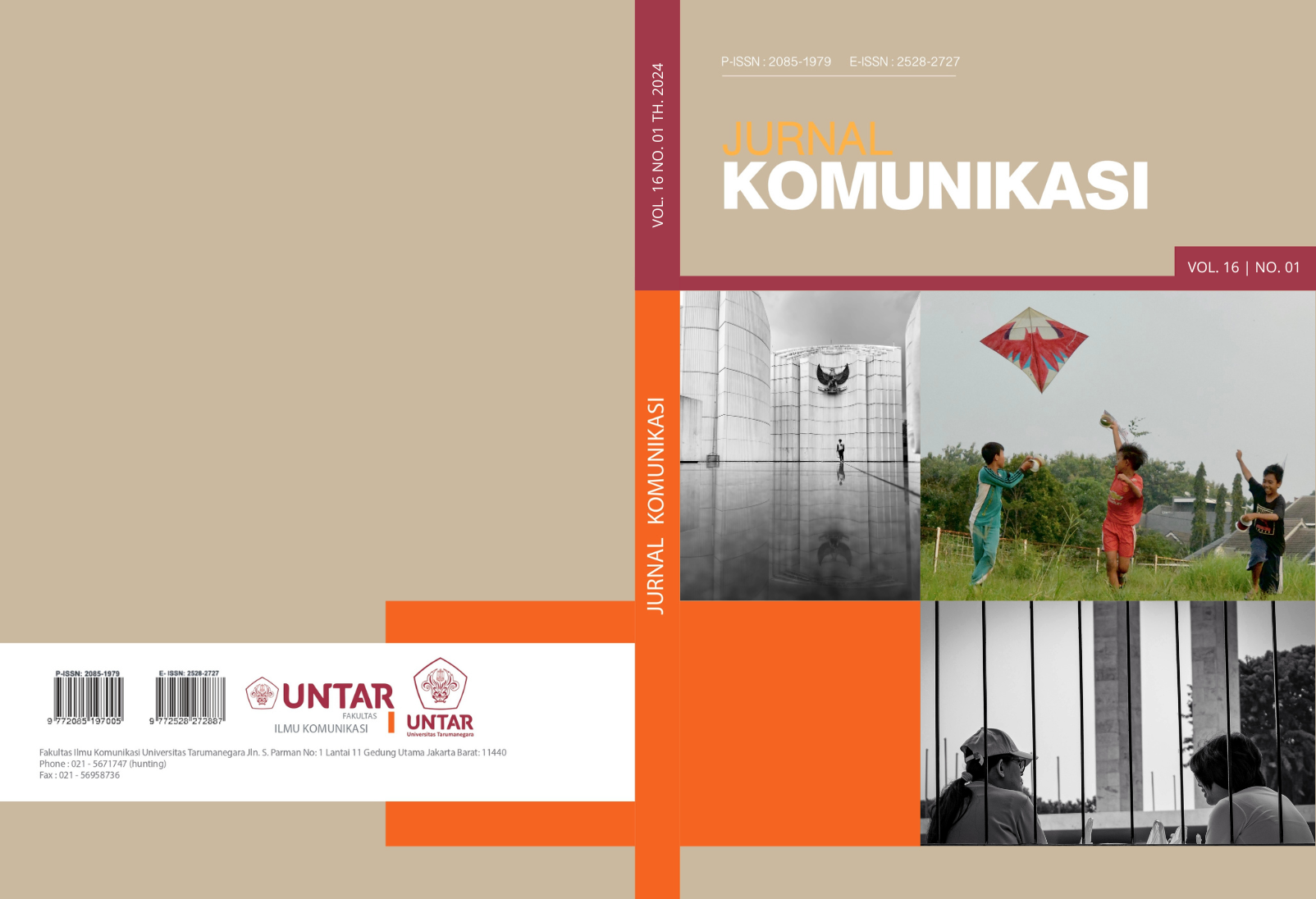Resilience of Participatory Communication Adolescent Community Communities in the Prevention of Child Marriage in Sukabumi
Main Article Content
Abstract
This research has an urgency that participatory communication resilience can be formed in communities with young ages, namely adolescents who are members of adolescent communities. This research focuses on how resilience is formed in adolescent communities to prevent child marriage in Sukabumi Regency to improve the ability of adolescents and advocate for vulnerable peers trapped in child marriage. This research uses qualitative research methods with a case study approach to explore the experiences of adolescent members of 5 regional children's forums in Sukabumi as research subjects who actively participate in the prevention of child marriage through the Yes I Do program. The results showed that participatory communication of child communities in preventing child marriage in formal and informal peers showed the collaboration of child communities with diverse cross-communities (heteroglacia). In addition to heteroglacia, Wabinar Activities are open dialogue and sharing experiences and knowledge with peers (dialogue) Movie watching and business class activities are a process to unite some of the differences that exist into an understanding about the impact of child marriage (polypony). Youth Camp and Watch Together activities filled by the children's community are a form of fun participatory communication (carnival). The children's community builds meaning, persistence, self-confidence, patience, independence or what is referred to as peer resilience with peer education activities. Resilience in adolescents who are vulnerable to being trapped in child marriage is an important period and affects the basis of adulthood, individual changes and life development.
Article Details
Section

This work is licensed under a Creative Commons Attribution-ShareAlike 4.0 International License.
This work is licensed under a Jurnal Komunikasi Creative Commons Attribution-ShareAlike 4.0 International License.How to Cite
References
Badan Pusat Statistik. (2020). Pencegahan Perkawinan Anak (Percepatan yang tidak bisa ditunda). Jakarta: Badan Pusat Statistik.
Carolyn Kabore, E. W. (2020). COVID-19 Aftershocks: Out of time . London: World Vision International.
Creswell, J. W. (2018). Pendekatan Kualitatif dan Desain Riset. Memilih Di Antara Lima Pendekatan. Jakarta: Pustaka Pelajar.
Hasan, S. (2018). Model Komunikasi Pada Program Csr Pemberdayaan Wirausaha Muda Perusahaan Migas. Interdisiplinary Journal of Communication, 59-82. https://doi.org/10.18326/inject.v3i1.59-82
Hendayani, S. N., Rosyeni, Y., & Setiowati, T. (2022). Care Management of Premarital Women Using Clear Counseling Techniques, Roles Body Attitudes and Gather Approaches. Science Midwifery, 10(5), 4155-4159. https://doi.org/10.35335/midwifery.v10i5.996
Indriawan, T., & Kusumaningrum, T. A. (2021). Efektifkah Pendidikan Kesehatan Reproduksi Remaja oleh Teman Sebaya? Griya Widya: Journal of Sexual and Reproductive Health, 14-26. https://doi.org/10.53088/griyawidya.v1i1.247
Kahn, N., & Graham, R. (2019). Promoting Positive Adolescent Health Behaviors and Outcomes: Thriving in the 21st Century. Washington DC: National Academies of Sciences, Engineering, and Medicine; Health and Medicine Division; Division of Behavioral and Social Sciences and Education; Board on Children, Youth, and Families; Committee on Applying Lessons of Optimal Adolescent Health to Improv.
Kementerian Perencanaan Pembangunan Nasional/Bappenas. (2020). Strategi Pencegahan Pekawinan Anak. Jakarta: Kementerian Perencanaan Pembangunan Nasional/Bappenas.
Kusmarni, Y. (2012). Studi kasus. Yogyakarta: UGM Press.
M. Afdhal Chatra P, K. A. (2021). Metode Penelitian Kualitatif: Panduan Praktis untuk Analisis Data Kualitatif dan Studi Kasus. Jami: PT. Sonpedia Publishing Indonesia.
Maithreyi, R. (2018). Children’s reconstruction of psychological knowledge: An ethnographic study of life skills education programmes in India. Childhood. http://dx.doi.org/10.1177/0907568218798014
Mies, G., Limijaya, S., & Restuningrum, N. H. (2016). Pernikahan Anak di Sukabumi Jawa Barat: Diri dan Agensi Anak Perempuan(Child Marriage in Sukabumi West Java: Self and Agency of Girls). Jurnal Perempuan, Vol 21 no.1 tahun 9-33. http://dx.doi.org/10.34309/jp.v21i1.12
Miles, M. H. (2014). Qualitative Data Analysis, A. Methods Sourcebook, Edition 3. USA: Sage Publications.
Moleong, L. (2016). Metodologi Penelitian Kualitatif. Bandung: Remaja Rosdakarya.
Muchtar, K. (2014). Komunikasi partisipatif pada sekolah lapangan pengelolaan tanaman terpadu (SL-PTT). Jurnal Komunikasi Pembangunan, 12(1). https://doi.org/10.46937/1220148652
Paat, Y. F. (2013). The Bioecological Model of Human Development. Journal of Human Behaviour in the Social Environmnet, issue 8. https://doi.org/10.1002/9780470147658.chpsy0114
Pintu Paul, M. D. (2020). Child Marriage in India: A Human Rights Violance During the Covid-19 Pandemic. Asia Pacific Journal of Public Health, 1-2. https://doi.org/10.1177/1010539520975292
Qudsyi, H. (2015). Program Peer Education sebagai Media Alternatif Pendidikan Kesehatan Reproduksi Remaja di Indonesia. Prosiding Seminar Nasional Dept. Psikologi (pp. 110-114). Yogyakarta: Universitas Islam Indonesia.
Qudsyi, H. (2015). Program Peer Education Sebagai Media Alternatif Pendidikan Kesehatan Reproduksi Remaja Di Indonesia. Seminar nasional (pp. 110-114). Yogyakarta: Universitas Islam Indonesia.
Rahim. (2004). Participatory Communication Working for Change and Development. New Delhi: Sage Publication India Pvt Ltd.
Saraswati, R. (2015). Hukum Perlindungan Anak di Indonesia. Bandung: PT. Citra Aditya Bakti.
Sulistiyani, A., Hijriyah, A., Hamiidah, N., Hendaliani, N., & Zulfa, M. (2023). Pendampingan Remaja Desa dalam Mengatasi Permasalahan Pernikahan Dini melalui Komunitas PIK Remaja di Desa Wonokampir, Kecamatan Watumalang Kabupaten Wonosobo. Jurnal Pengabdian, Riset, Kreativitas, Inovasi, dan Teknologi Tepat Guna, 1-10. https://doi.org/10.22146/parikesit.v1i1.8049
William Maliki, E. A. (2021). Komunikasi Partisipatif dalam Pengelolaan Hutan Adat Pada Komunitas Adat Benuaq Muara Tae, Kabupaten Kutai Barat. eJournal llmu Komunikasi, 108-119.
Yin, R. K. (2014). Case Study Research Design and Methods (5th ed.). . Thousand Oaks.

